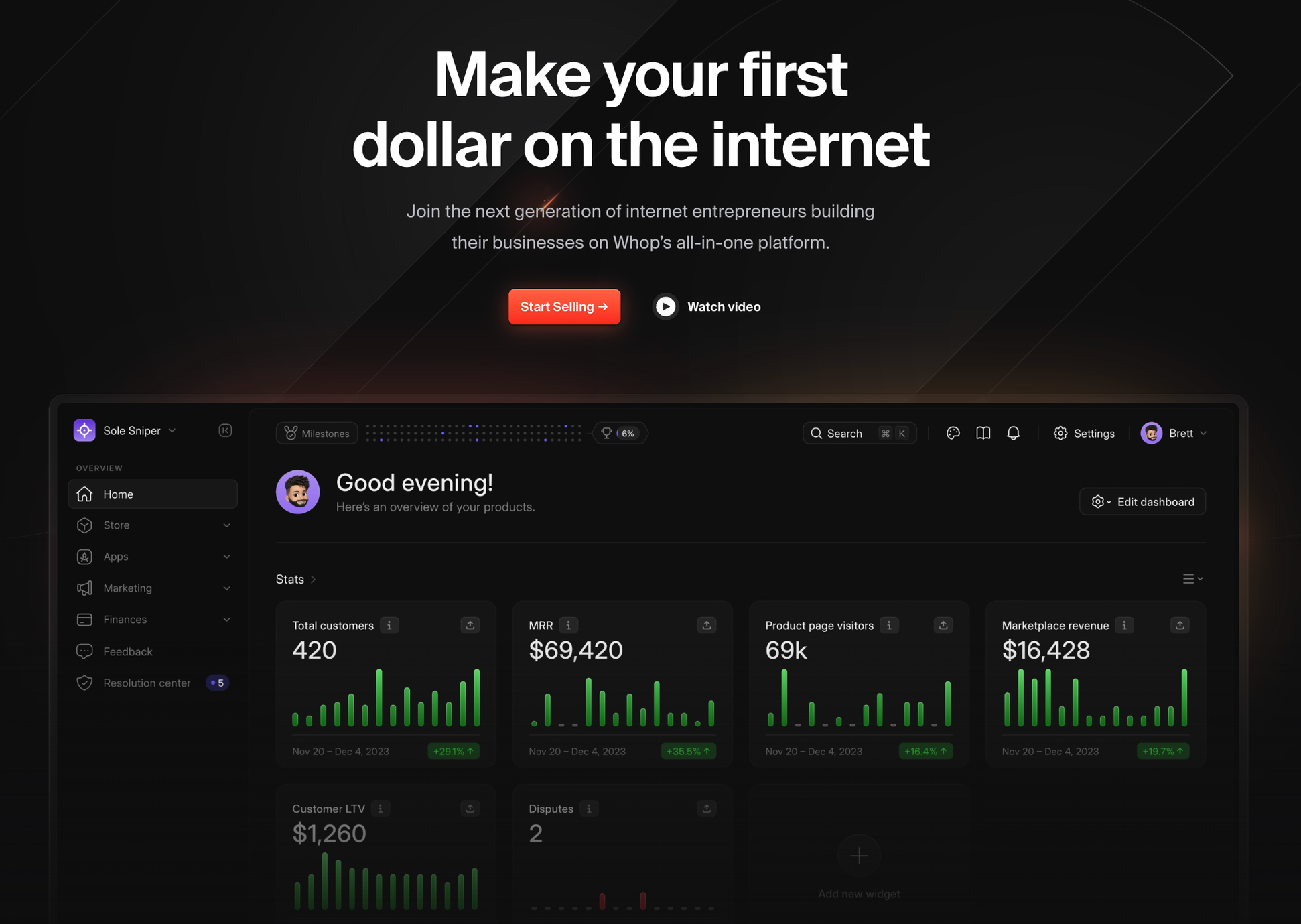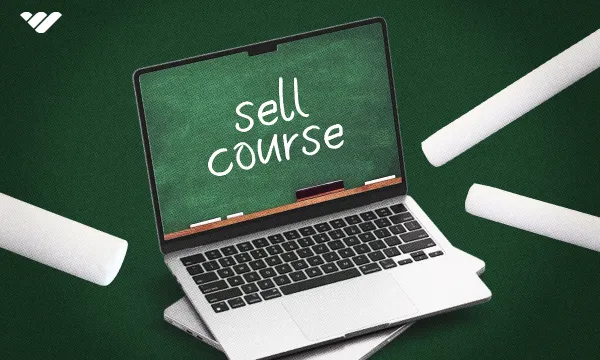Online courses and e-learning are a staple of today’s online environment, and since its inception back in 2007, the Massive Open Online Course (MOOC) industry is now valued at around 23 billion dollars. Many researchers suggest that this sharp growth is set to continue into the foreseeable future, reaching $119 billion across 1 billion consumers by 2029.
This sort of growth makes online courses and e-learning a field of vast opportunity, and you’re already doing yourself a big favor by thinking about selling courses of your own.
With the market for courses widening every day, time is of the essence – but you’re in luck, because selling an online course isn’t as difficult as it might appear. Read on for 5 steps you can follow to start earning money with online courses.
How Much Money Can You Make Selling Online Courses?
Over 220 million learners are taking online courses today on a variety of platforms. Selling courses of your own gives you a great chance to carve a piece of that ever-growing pie.
In fact, courses are one of the best sources of revenue within the creator economy. It’s hard to pin an exact figure on how much you can expect to make, but creator platform Kajabi reported this year that courses were the primary revenue earner among six-figure creators. That’s right – the most successful creators are earning far more from courses than they are from membership sites like Patreon, which you probably hear touted more than anything else.
Further underlining the revenue potential of courses, several companies have built out billion-dollar business models just connecting course creators with audiences. Earlier this year, Udemy and Coursera had a market capitalization of $1.55 and $1.51 billion respectively while 2U (an educational tech company) was valued at $28.4 billion.
If nothing else, these numbers show that online courses are a massive part of the ecommerce landscape today, and you can become part of this rapidly growing industry by selling your own courses.
How to Sell Online Courses in 5 Easy Steps
Now that you know what the e-learning landscape looks like, let’s jump into the process of actually selling your online course. If you have your course built and ready to go you can skip ahead to step 3, but otherwise start here for the full rundown of creating and selling courses.
1. Pick Your Niche and Course Subject
The most important step in selling online courses is to figure out exactly what sort of course you want to create, and that comes from two things—market research, and your own expertise. The latter is most important, because as a course creator you want to be able to offer something unique, either in terms of exceptional skill and knowledge or a level of communication that goes beyond the norm.
So, start with what you know, and think about your personal experience, interests, and even hobbies. You’ll be surprised at just how well incredibly niche courses do—anything from painting tabletop figurines to Shopify dropshipping to age or hobby-specific workouts could make for excellent online course material.
The next step is to do some market research and validate your course idea. If you think painting figurines is what you want to teach, check out the market. Look at the different types of figurines out there, where the market tends to be located, and what the demographics are like in the niche. That will give you an idea not only if your course is viable or not, but also inform a lot of decisions later on in the process.
Social media and creator platforms are excellent points of contact for research, and you’ll want to check out platforms like Instagram, YouTube, and TikTok to see what creators are doing in your chosen niche. The sizes of some of the accounts in terms of followers or subscribers within what you thought was a very small niche may surprise you.
2. Start Creating Your Course

Once you have a handle on the niche and know what you can do, it’s time to pick a course topic and get creating. This will tie in with branding as well, and it’s a lot to consider. You’ll need to:
Think about branding: If you don’t already have an audience or reputation as a niche expert or creator, you should put a little thought into how you want to be seen going forward. It’s tough to rebrand once you’ve made an impression, so think about this one right now, and decide how you want to be known. This will dictate the tone of your content, and even the name you go by can have an impact—a lot of creators use their real names and establish a personal brand, but you can just as easily look to set things up as a company and position yourself as its face. The key point here is to tell a story through which your audience can connect to you.
Create a tagline: A good tagline is an extremely valuable extension of your brand identity and concept, and it can help underline what you’re trying to do in terms of positioning. You can attach it to your branding at every opportunity to really drive home what your brand is and what you’re trying to do.
Outline your course: Despite the importance of all things branding, the most critical thing here is to actually create a great course—and one way to make sure that you get the entire package right the first time is to start with an outline. Conceptually, you can start at the solution and then work backward, mapping out the sequence in which you’ll take your learners to where they need to be. Match the level of the course to where your audience is at (which you’ll know through your market research) and ensure that each lesson follows smoothly from the previous.
Insert your course content: Once your outline is complete, the actual course content shouldn’t be too difficult to manage since you really just need to fall back on your expertise in order to color between the lines. Focus on effective communication and using the right words, images and other media to get the message across. Creating your course is an iterative process, so cycle through a few times, and don’t be afraid of enlisting help to ensure you haven’t missed anything.
Format and proofread: Once your course is complete, remember that you still need to polish it. First of all, make sure you’re creating it in the right format for your learners and for the message within – some subjects are easier in text, others work best in video. Proofreading and editing is also crucial, since nothing kills a digital product faster than consumers getting the impression that it’s been rushed or contains basic errors.
3. Choose the Right Course Platform

We’ve already name-dropped a few course platforms in this article, but that’s not even the tip of the iceberg when it comes to what’s out there. There are lots of great course platforms to choose from, from standalone platforms that help you with one aspect of the process to all-in-one platforms that take over much of it, as well as marketplaces where consumers can browse different courses like yours and choose the one they like the look of.
Picking the right platform for you is a matter of understanding your capabilities, where you are in your journey as a creator, and what you want to accomplish from your courses. Some platforms, such as the aforementioned Kajabi, can cost three figures every month and be prohibitive for new creators, while you might never even get discovered on a platform like Udemy without strong branding and marketing.
Some platforms are also better for certain niches than others, while yet others might give you more opportunities to grow. Whop, for instance, allows you to create your own whop - a space where your online course is only one part of the mix. With your whop you can also set up applications for your community and sell other kinds of products, meaning multiple revenue streams in one place.
4. Design Your Marketing and Sales Funnel

Once your course is ready and situated on a platform, you’re ready for liftoff, but it helps to ensure you’re giving yourself as many thrusters and as much rocket fuel as you can. One way to do this is to pay particular attention to your sales funnel, or the process through which people can find and buy your course.
What this boils down to is a factor of the Unique Selling Proposition (USP) you’re offering and how much your course costs. We mentioned expertise earlier, and that’s an example of a USP—imagine learning how to play golf from Tiger Woods, how to invest from Warren Buffett or how to box from Mike Tyson.
Now, you don’t have to be the Tiger or Buffett of your chosen niche, and a great USP can come from several sources – and sometimes, it’s how you spin it. If you know you can get people promoted by teaching a negotiation course or improve their life and health by teaching them some exercises, those are just as valuable in terms of USP and you should make sure to broadcast the fact.
Pricing is also a critical aspect of your sales funnel, but don’t stress – you don’t have to get it right the first time. It’s always possible to change pricing, offer discounts, and even conduct wholesale pricing experiments down the line. Your course’s pricing should reflect its value and USP, so don’t shoot too low. Many creators prioritize high ticket sales, but you can also innovate by mixing in other payment models such as subscriptions and plans.
Here are a few considerations when it comes to pricing your online course:
Market conditions: The e-learning landscape is constantly changing, and you’ll find that certain types of courses are more in demand than others. When the stock market booms, for example, you’ll find that trading courses are particularly hot. These sorts of macro factors should definitely come into any pricing discussion.
Certification: If you are in a position where you can award your course participants with some sort of accreditation, that’ll definitely factor into your USP and justify a higher price than similar courses without the certificate upon completion.
Course length and content: Some courses go into far more depth than others, and it’s fair game to charge based on how much effort and material goes into the course prep. A longer course chock-full of knowledge should be valued as such.
Cost: If you’ve invested in different tools and software to create your course in order to heighten the quality of the product, you should be pricing those costs in. Treat it like any other product, project your sales figures and work out your margins. Read this guide to understand how to price your online course.
Beyond the USP and pricing of your course, you should also pay attention to your landing pages. This is where your visitors arrive when they click on any of your ads or social media posts, so make sure it looks good. You want an attractive page with all the salient info, calls to action, engaging multimedia, and the offering itself.
If you don’t consider yourself an expert when it comes to web development and design, don't worry. A lot of all-in-one course platforms set up fantastic landing pages for you, allowing you to choose from different templates and customize your branding. These pages can serve as your course website and online storefront, making them a versatile and most importantly easy solution.
Lastly, you should consider a lead sequence for your online course or digital business. You’ve probably seen lots of other entrepreneurs, ecommerce companies, and even big firms trying to score your email address. Well, when you give a business your email, you become a lead, and you’ve been added to their email lists.
You can convince people to part with their email addresses by offering some sort of value—usually, a discount on your course or some sort of digital download, even a small eBook where they can sample your content, will do the trick.
That’s called a lead magnet, but to get people to the point where they can see your lead magnet, you need to generate traffic. You can do this via content marketing and SEO through a blog or YouTube channel, run a paid ad campaign, or connect with influencers and creators in your niche to either make guest appearances on their channels or run affiliate marketing programs.
5. Launch Your Course
That’s it, you’re ready to launch! It’s all systems go, and all the hype you’ve built up through outreach, guest content, marketing, and building that email list can be put to work. You’ll be activating your email sequence to first let people know that the course they’ve waited for is going live, and issuing follow-ups and reminders as appropriate.
Your social media can also go into overdrive at this point, and remember to plan for what happens after you sell your course. Collecting reviews and testimonials can be an incredibly effective way of gaining even more sales, and you can keep happy course participants in your community and email list in order to target them with your next digital product, whether it’s another course, an eBook, coaching, membership, or something else entirely.
Why Whop is the Best Place to Sell Your Online Course

A good course platform can be your best friend when selling your online course, and there’s no better option to have in your corner than Whop. As an all-in-one platform, Whop offers everything you need from a powerful course-builder via the courses app that you can simply drag and drop into your whop, alongside a variety of other features that can be of use.
What makes Whop an excellent option for course creators is it's flexibility and ease of use. An online course brings one income stream, but with Whop you can turn this one into many. You can create a community around your course and sell access to that. Sell low-cost downloadables (like worksheets) as complementary products for your course. And it doesn't stop there - why not create high-ticket services such as masterminds, video classes, or one-on-one coaching. With Whop, cross-selling and upselling with easy and natural.
Whop even goes the extra mile by serving as a Merchant of Record on your behalf, meaning that not only are payments fully taken care of in well over a hundred currencies and territories, but liability is also lifted off your back. Best of all, Whop only charges 3%, which is significantly less than any other major platform.
So, if courses are your game, Whop might just be the name. Check out Whop and start selling your course in minutes.
Course FAQs
How do you sell video courses online?
You can sell video courses online in much the same way as a standard online course, and most course platforms allow video uploads—there are also platforms that specialize in video courses.
How to sell courses from your own website?
If you want to sell courses from your own website, you can take care of all the hosting and web development while integrating a service like Whop to look after the digital fulfillment side of things via API.
How to create online courses?
The easiest way to create an online course is to sign up with a course platform and use their course builder tool or app. That way you can create courses without any real web development expertise or expensive software.
Can people find my course on a course platform?
Many course platforms only host creators, and it’s usually just marketplace-style platforms which are consumer-focused and feature discovery. Whop offers the best of both worlds, giving creators a digital storefront while also letting users browse creator pages of different kinds and generating sales through discovery.





